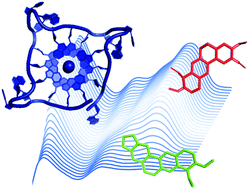Polymorphism of human telomeric quadruplexes with drugs: a multi-technique biophysical study†
Abstract
The human telomeric G-quadruplex structural motif of DNA has come to be known as a new and stimulating target for anticancer drug discovery. Small molecules that interact with G-quadruplex structures in a selective way have gained impressive interest in recent years as they may serve as potential therapeutic agents. Here, we show how circular dichroism, UV resonance Raman and small angle X-ray scattering spectroscopies can be effectively combined to provide insights into structural and molecular aspects of the interaction between human telomeric quadruplexes and ligands. This study focuses on the ability of berberine and palmatine to bind with human telomeric quadruplexes and provides analysis of the conformational landscape visited by the relevant complexes upon thermal unfolding. With increasing temperature, both free and bound G-quadruplexes undergo melting through a multi-state process, populating different intermediate states. Despite the structural similarity of the two ligands, valuable distinctive features characterising their interaction with the G-quadruplex emerged from our multi-technique approach.



 Please wait while we load your content...
Please wait while we load your content...